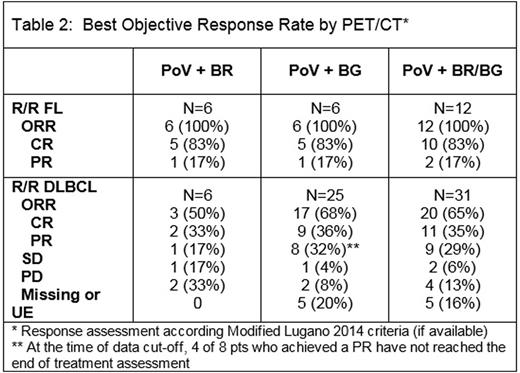Abstract
Introduction: Patients with transplant ineligible R/R FL or DLBCL have poor outcomes. Polatuzumab vedotin (PoV) is an antibody drug conjugate (ADC) designed for the targeted delivery of the potent microtubule inhibitor MMAE to cells expressing CD79b. PoV combined with R has previously demonstrated promising response rates in patients (pts) with R/R FL and DLBCL. The addition of B to PoV-R and substitution of G for R could improve outcomes in these pts. We report preliminary results from the safety run-in portion of a Phase Ib/II study evaluating PoV combined with BR or BG in R/R FL or DLBCL and the expansion cohort evaluating PoV combined with BG in R/R DLBCL (ClinicalTrials.gov NCT02257567).
Methods: This multicenter, open-label study evaluates the safety and tolerability of PoV combined with B (90 mg/m2) and R (375 mg/m2) or G (1000 mg). Adult pts were treated with PoV 1.8 mg/kg intravenously with BR or BG every 28 days for FL pts and every 21 days for DLBCL pts for a total of 6 cycles. Response assessment was performed following 3 cycles of study treatment (tx), end of study tx, and every 6 months for 2 years during the follow-up period.
Results: As of May 2, 2016, 45 pts have been enrolled; 24 pts (12 FL, 12 DLBCL) in the safety run-in portion and 21 R/R DLBCL pts the expansion cohort. Baseline characteristics for safety-evaluable patients are shown in Table 1. At the time of this report, all 24 pts in the safety run-in portion and 19 pts in the expansion cohort have completed at least one response assessment.
Among the 44 pts enrolled in the FL and DLBCL cohorts who received at least one dose of study tx, the most common adverse events (AEs) in > 20% of pts were nausea (50%), diarrhea (45%), fatigue (39%), pyrexia (29%) and constipation (27%).
In the FL safety run-in cohorts, 67% (8/12) patients had Grade 3/4 AEs and 25% (3/12) had serious AEs (SAEs). The most common Grade 3/4 AEs in ≥ 10% of FL pts were neutropenia (33%) and thrombocytopenia (17%) and were attributed to study tx. No single SAE occurred in more than 1 pt. AEs led to study tx interruption in 2 pts and one pt discontinued bendamustine due to grade 3 thrombocytopenia. Treatment-emergent Grade 1 peripheral neuropathy was reported in 3 pts and did not lead to study tx discontinuation. PoV was dose reduced from 1.8 mg/kg to 1.4 mg/kg in 1 pt with Grade 1 neuropathy who was able to complete study tx.
In the DLBCL safety run-in and expansion cohorts, 78% (26/32) of safety-evaluable pts had Grade 3/4 AEs and 53% (17/32) of pts had SAEs. The most common Grade 3/4 AEs in ≥ 10% of pts were neutropenia (25%), thrombocytopenia (13%), and pneumonia (13%) and the most common SAEs ≥ 10% of pts were pneumonia (19%) and pyrexia (16%). AEs led to study tx interruption in 15 pts and led to study tx discontinuation in 5 pts. Three pts died due to AEs (1 due to general physical health deterioration, 2 due to pneumonia) all of which were not related to study tx. One pt died due to progressive disease. Grade 1 peripheral neuropathy was reported in 5 pts and did not lead to study tx interruption or discontinuation. Grade 2 peripheral motor neuropathy was reported in 1 pt, which led to study tx discontinuation.
Best objective response by PET/CT for evaluable pts as of May 2, 2016 is reported in Table 2.
The objective response rate (CR+PR) was 100% in R/R FL and 65% in R/R DLBCL. The majority of pts who achieved a CR or PR remain in response. Of the 3 DLBCL pts who achieved a CR or PR on the PoV + BR safety run-in cohort, all 3 remain in remission with a median follow-up of 8.4 months with one pt remaining in response for 14 months. 83% (5/6) of FL pts continue to be in CR or PR with 3 pts remaining in response for over 9 months. The duration of responses for pts treated on the PoV + BG is not reported due to insufficient follow-up and will be updated at the time of presentation.
Conclusions: Preliminary evaluation of efficacy showed promising durable responses in heavily pre-treated R/R FL and DLBCL patients. In addition, PoV combined with BR or BG has an acceptable safety profile in pts with R/R FL and DLBCL and confirmed the PoV dose of 1.8 mg/kg to be the recommended phase 2 dose. The safety and efficacy data will be updated at the time of presentation.
Herrera:Genentech: Research Funding; Immune Design: Research Funding; Merck: Research Funding; Pharmacyclics: Research Funding; Seattle Genetics: Research Funding; Adaptive Biotechnologies: Research Funding. Assouline:BMS: Speakers Bureau; Lundbeck: Consultancy; Janssen: Consultancy, Speakers Bureau; Pfizer: Speakers Bureau. Kamdar:Seattle Genetics: Speakers Bureau. Mehta:Merck: Research Funding; Pharmacyclics: Research Funding; Roche Genentech: Research Funding; Medimmune: Research Funding; Seattle Genetics: Membership on an entity's Board of Directors or advisory committees; Incyte: Research Funding; Bristol Myers Squibb: Research Funding. Fleury:Lundbeck: Consultancy, Speakers Bureau; Gilead: Consultancy, Speakers Bureau; Roche: Consultancy, Speakers Bureau; Amgen: Consultancy, Speakers Bureau; Janssen: Consultancy, Speakers Bureau; Seattle Genetics: Consultancy, Speakers Bureau; Novartis: Consultancy, Speakers Bureau. Kim:Celltrion, Inc.: Consultancy, Honoraria. Bosch:Hoffman La Roche: Consultancy, Honoraria, Research Funding; Millennium: Research Funding. Radford:Novartis: Honoraria, Speakers Bureau; Seattle Genetics: Honoraria, Speakers Bureau; GSK: Equity Ownership; Astra-Zeneca: Equity Ownership; Takeda: Consultancy, Honoraria, Research Funding, Speakers Bureau. Bu:Roche: Employment. Hong:Genentech: Employment. Sehn:roche/genentech: Consultancy, Honoraria; amgen: Consultancy, Honoraria; seattle genetics: Consultancy, Honoraria; abbvie: Consultancy, Honoraria; TG therapeutics: Consultancy, Honoraria; celgene: Consultancy, Honoraria; lundbeck: Consultancy, Honoraria; janssen: Consultancy, Honoraria.
Author notes
Asterisk with author names denotes non-ASH members.



This feature is available to Subscribers Only
Sign In or Create an Account Close Modal